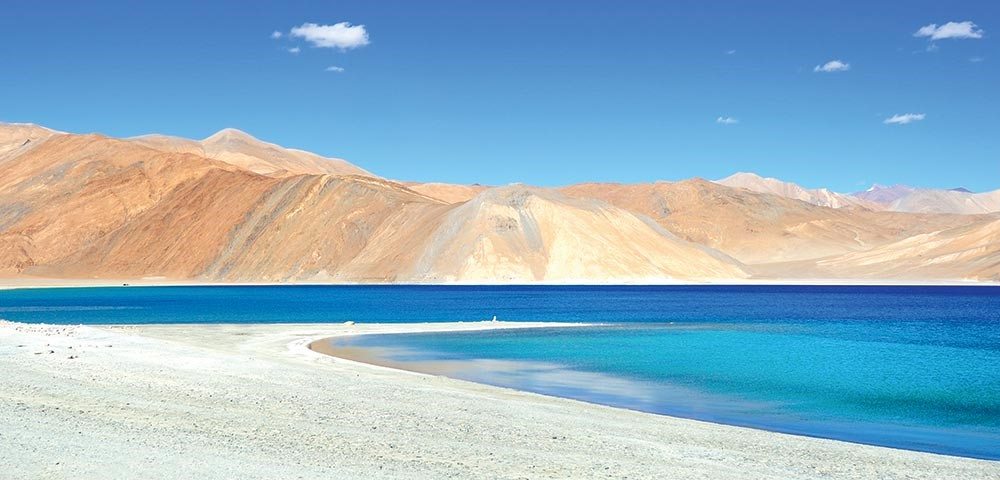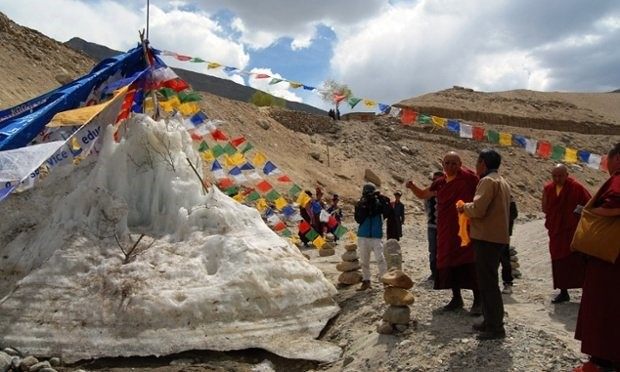Imagining Incredible India: Saving Ladakh through Sustainability

Using the Ladakhi way of life to combat effects of climate change
“There are some parts of the world that, once visited, get into your heart and won’t go. For me, India is such a place. I had been seeing the world in black & white and, when brought face-to-face with India, experienced everything re-rendered in brilliant technicolor” — Keith Bellows, National Geographic
Tourism in India accounts for over 7% of GDP [1]. Ecologically, India is one of most biologically diverse countries with landscapes ranging from the mighty mountains, the humble seas, the enchanting deserts to the lush forests. One such jewel located in the northernmost region of India, is a high altitude desert called Ladakh, also known as moon land. Ladakh is home to about 270,000 people [2] and is known for some of the most beautiful and ancient monasteries located against a magical landscape of high altitude mountains and desert plains. Ladakh by virtue of its location and remoteness is an extremely ecologically sensitive location which opened up to tourism in 1974 when about 500 tourists visited. Today over 200,000 people visit each year during the summer months [3] which has reaped several economic benefits but has created a major strain on the resources of the fragile ecosystem.
[Pic 1: the famous Pangong Tso Lake in Ladakh. Photograph: SOTC.com]
Even as global nations continue to arrive at a consensus to tackle climate change, nowhere are the effects more visible than in the mountainous region of Ladakh, putting lives here at a great risk. Snowfall has come down significantly (from 3ft to 0.2ft) in the last couple of decades [4] and the glaciers are melting at a higher rate, which is evident from the Siachen glacier whose starting point receded by about a kilometre since 2005 [5]. With about 90 per cent of farmers in Ladakh relying on self-sustaining farming practices [6], irrigation by snow and glacial water is a major contributor to the productivity of agriculture which is at great risk. Rainfall has also become extremely erratic – the region used to receive an average of 15mm which reached 250mm in one hour during the cloud burst in 2010 killing 248 people and causing $30 M of damages [7]. Furthermore, flash floods in the neighboring region of Uttarakhand killed more than 10,000 people and trapped over a 100,000 people raising doubts on the long term sustainability of Ladakh [8].
 [Pic 2: The blue band across the Himalayas shows snow cover declining by at least 16 percent: CSEIndia.org]
[Pic 2: The blue band across the Himalayas shows snow cover declining by at least 16 percent: CSEIndia.org]
In order to combat some of these challenges, non-profit organizations such as Ladakh Ecological Development Group (LEDeG), are focusing on promoting sustainable development that harmonize and build on traditional Ladakhi culture. These organizations promote efficient use of groundwater and work with the Ladakhis on localized renewable energy projects such as installation of community based solar power plants which is fed by over 300 days of sunlight. The government has declared the use of electricity for heating to be a ‘social ill’ and people have embraced solar power heating systems [9]. The locals also play their part by resorting to the traditional Ladakhi way of life by leading a very simple lifestyle, using a compost pit for waste and taking a bath only once in 2-3 days in the cold weather [10]. A local engineer known as the “Iceman”, Chewang Norphel has pioneered an innovative solution to water shortage by creating artificial glaciers by using stone embankments to trap snow for later use. These artificial “glaciers” provide water to irrigate farmland when there is not enough water available from natural glaciers [11]. Driving sustainability is a community effort and Ladakhis are trying their best to preserve their beautiful homeland. However there is lots that still needs to be done.
[Pic 3: An artificial glacier made in the form of an ice stupa in Ladakh. Photograph: Secmol.org]
With uncontrolled tourism creating additional strain on the ecological imbalance created by climate change, it is critical that Ladakh strives to become an ecotourism destination. Ecotourism is responsible travel to natural areas that conserves the environment, sustains the well-being of the local people, and involves education of both communities and tourists. Local authorities could learn from other ecotourism destinations such as Bhutan which have committed to “absorbing more carbon than we emit and to remain a net sink for global greenhouse gases”. There could be strict standards and guidelines for how development and tourism in Ladakh should progress, such as limiting the number of tourist arrivals, building green eco-lodges and curbing illegal poaching of exotic wildlife. Taking inspiration from Costa Rica, only those businesses that have a certificate for sustainable tourism should be allowed to operate and fees should be charged to allow maintenance and upkeep of popular tourist attractions. As ecotourism becomes a more conscious effort from global travelers, local communities can take charge to preserve their home.
Just like our little blue planet, Ladakh is one of its kind, and it is up to us to preserve it so we can share it with our future generations. It is high time that we understand that “Plans to protect air and water, wilderness and wildlife are in fact plans to protect man” – Stewart Udall
(800 words)
[1] Knoema Data. Retrieved from https://knoema.com/atlas/India/topics/Tourism/Travel-and-Tourism-Total-Contribution-to-GDP/Total-Contribution-to-GDP-percent-share
[2] Wikipedia. Retrieved https://en.wikipedia.org/wiki/Ladakh
[3] Official Leh Tourism. Retrieved from http://leh.nic.in/depts/tour/def.html
[4] Down to Earth. Retrieved from http://www.downtoearth.org.in/coverage/warning-from-leh-1872
[5] The Hindu newspaper. Retrieved from http://www.thehindu.com/sci-tech/energy-and-environment/climate-change-is-changing-landscape-of-ladakh-glacier-man-chewang-norphel/article7927780.ece
[6] Reach Ladakh. Retrieved from http://www.reachladakh.com/impact-of-climate-change-on-agriculture-in-ladakh/2292.html
[7] Tehelka Media company. Retrieved from http://www.tehelka.com/2013/06/climate-change-dries-up-water-in-ladakh/
[8] Wikipedia. Retrieved from https://en.wikipedia.org/wiki/2013_North_India_floods
[9] Dromomaniacs by Edward Hewitt. Retrieved from http://www.dromomaniacs.com/article/4-lessons-for-sustainable-development-from-leh-ladakh/
[10] SouthAsia News. Retrieved from http://southasia.oneworld.net/peoplespeak/tourism-becomes-a-major-ecological-concern-in-ladakh#.WBzsvyQXsu_
[11] The Guardian. Retrieved from https://www.theguardian.com/environment/2015/feb/24/artificial-glacier-could-help-ladakh-villagers-adapt-to-climate-change





One of the issues which places such as Ladakh is that while they do not contribute significantly to environmental damage, they are a major victim – this skewed cause-effect profile for them, and similar but inverted for others, creates wrong incentive structures and is one of the major complications in environment control. For instance, someone emitting greenhouse gases in another country will have little but tangible effect on Ladakh and hence may not bother about conserving its climate.
I agree with Siddharth that Ladakh is an unfortunate victim of externalities from pollution from elsewhere. To complicate matters even further for Ladakh, I wonder if its people are in a position to turn away tourism business that is not in line with their ecotourism standards. In the IKEA case that we studied, one of IKEAs options was to increase the requirements on their wood suppliers, and since they were such a large corporation, they likely had enough leverage to make this happen. However, my fear is that if Ladakh raises its standards too high, it will turn away tourism – something that goes a long way to supporting the local economy.
This article perfectly highlights a global conundrum: those who pay the price for human-driven climate change are often not those who drove it. It saddens me that the Ladakh people are suffering so acutely from climate change, and I feel pessimistic as to whether any mitigation strategies will be sufficient to avoid eventual relocation by the Ladakh people. Your point on the detrimental effects of tourism to a fragile habitat is a guilt that I struggle with. As Johnson said in class the other day, it’s impossible to measure something without affecting it; I likewise feel that it’s impossible to visit a place without changing it, and as much as I love to travel, I hate knowing that my existence there will leave it different than I found it. I don’t know that ecotourism is even the best answer. Maybe places that are radically impacted by tourism should operate on a permit system, with a threshold to limit overall visits. Regardless, I feel for the Ladakh people, and am inspired by their efforts to sustain their way of life despite the high obstacles in their path.